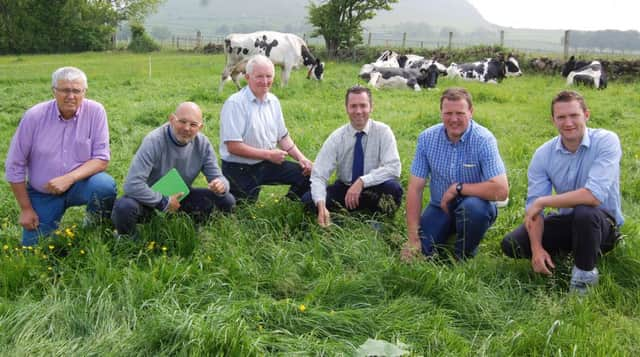Italian nutritionists get a feel for grass


Organised by United Feeds, in conjunction with Provimi, the farm walk provided the Italian visitors with an opportunity to gauge the management skills required to produce high levels of milk from grazed grass using Holstein Friesian cows.
The father and son team are currently milking 110 cows, averaging 10,400 litres at 4.03% butterfat and 3.21% protein. Milk from forage levels are currently averaging 2,000L per cow with SCCs coming in at 199. The current calving index is 371 days.
Advertisement
Hide AdAdvertisement
Hide Ad“We have installed two Lely milking robots over the past four years,” Allister explained.
“Out of parlour feeders have also been put in. But given current market conditions, we must further improve our milk from forage levels.
“Grazed grass is the cheapest fed that we can offer to our cows. And with this in mind, we have installed a grazing gate this year as well as updating the paddock system on the farm.
“This ensures that the cows have access to fresh grass throughout the grazing season. And, so far, the approach has been working well.
Advertisement
Hide AdAdvertisement
Hide Ad“We do not want to drop the output of the herd: it’s a case of getting the same level of performance, but ensuring that grazed grass is used more efficiently within the system.”
United Feeds’ nutritionist Bobby Irwin was one of the group participating in the visit to the McCullough farm.
He said that dairy farmers must make best use of grazed grass over the coming months.
“It is the cheapest source of feed for cows,” he added.
“Daily dry matter intakes of 15 kilos from grass alone can be achieved here in Northern Ireland. But to make this happen requires grassland management standards of the highest order being implemented.”
Advertisement
Hide AdAdvertisement
Hide AdMeanwhile, the visiting nutritionists from Italy were having a ‘field day’ literally, viewing the McCullough cows out in the paddocks.
“We have never seen dairy farming practised in this way before,” confirmed Mario Scovazzi.
“Most of the visiting group are from Northern Italy, where fresh grass does not feature in cow diets at all.”
But Scovazzi did confirm that he and his colleagues work closely with the 1,400 dairy farmers who supply milk specifically for Parmigiano-Reggiano (Parmesan) cheese production. European law classifies the Parmesan name, as having a protected designation of origin status.
Advertisement
Hide AdAdvertisement
Hide Ad“There are strict controls on the way the milk is produced and then processed for Parmesan production,” Scovazzi added.
“Currently, producers are receiving an average of €0.55/L for their milk.
“I know this might seem like a good price by producers in Northern Ireland. But the reality is that Parmesan producers in Italy are finding it extremely difficult to cover all of their costs at the present time.
“The precise nature of the entire Parmesan production process does not allow farmers to cut costs at all.”